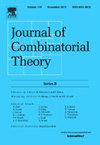注意简单拓扑图中的不相交面
IF 1.2
1区 数学
Q1 MATHEMATICS
引用次数: 0
摘要
证明了每个n顶点完备简单拓扑图至少生成Ω(n)对不相交的4面。这比Hubard和Suk最近的研究结果有所改进。作为直接推论,在单位方格中绘制的每一个n顶点完全简单拓扑图都会生成一个面积不超过O(1/n)的4面。这可以看作是四边形的Heilbronn问题的拓扑变体。我们构造了一些例子来证明我们的结果是渐近紧的。我们还讨论了任意k≥3的k面的类似问题。本文章由计算机程序翻译,如有差异,请以英文原文为准。
Note on disjoint faces in simple topological graphs
We prove that every n-vertex complete simple topological graph generates at least pairwise disjoint 4-faces. This improves upon a recent result by Hubard and Suk. As an immediate corollary, every n-vertex complete simple topological graph drawn in the unit square generates a 4-face with area at most . This can be seen as a topological variant of the Heilbronn problem for quadrilaterals. We construct examples showing that our result is asymptotically tight. We also discuss the similar problem for k-faces with arbitrary .
求助全文
通过发布文献求助,成功后即可免费获取论文全文。
去求助
来源期刊
CiteScore
2.70
自引率
14.30%
发文量
99
审稿时长
6-12 weeks
期刊介绍:
The Journal of Combinatorial Theory publishes original mathematical research dealing with theoretical and physical aspects of the study of finite and discrete structures in all branches of science. Series B is concerned primarily with graph theory and matroid theory and is a valuable tool for mathematicians and computer scientists.

 求助内容:
求助内容: 应助结果提醒方式:
应助结果提醒方式:


